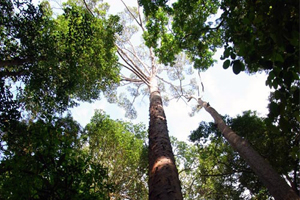Forest Degradation. Selangor which had experienced a loss of up to 10% of its forests in the 22 years between 1990 and 2012 continues to face forest degradation, a study by UKM scientists found.
The
deforestation was found to be due to economic and development factors
including increased farming and urbanisation arising from a growing
population.
Director
of UKM’s Institute of Climate Change (IKP), Professor Dr Sharifah
Mastura Syed Abdullah said the continued degradation of the remaining
forests is of a major concern.
Speaking
to UKM News Portal after a seminar on Space Sciences here, Prof Sharifah
Mastura said knowledge on deforestation and its driving forces in
Selangor is very important as it provides the basis for the calculation
of the total amount of carbon stock remaining above ground.
Carbon stock is the supply of carbon, especially carbon dioxide, kept in trees and other plants.
She said
the study provided an insight into appropriate measures that could be
taken to increase the area of trees to reduce the release of carbon
dioxide emission into the atmosphere.
Photographs
taken by satellites and land use maps from the Ministry of Agriculture
and Agrobased Industry showed the deforestation in Selangor had complex
causes.
She said
the reduction in forest cover in the state must be understood because
for decades perceptions and controversies of deforestation had persisted
in public debate.
Prof
Sharifah Mastura said the degradation was due to economic, institutional
and cultural practicesand policywith just over half related to
population dynamics and the rest due to agriculture, economic factors,
public policy and road networks.
She gave the following data:
| Factors Causing Deforestation in Selangor | Percentage |
| Population Dynamics | 54.4 |
| Agriculture Intensification | 18.2 |
| Economic | 13.6 |
| Public Policies | 9.1 |
| Road Networks | 4.5 |


Overall
forest loss in the 22 years was 2% from dipterocarp forestsmade up of
the largest trees and 8.6% from peat swamp forests.
While the
stastistics may not appear to be alarming, detailed analysis using the
Normalised Difference Vegetation Index (NDVI) showed the quality of the
forest had degraded widely.
Most researchers agree that forest cover is an important and critical feature as it plays a major role in maintaining the regional hydro-climate-ecological balance as well as life sustainability and well being on earth.
In
Malaysia forest and grassland conversion was fourth in the source of
carbon dioxide emission in the country, contributing 14%. Continuous
conversion of forest to other land use is responsible in the releasing
of carbon dioxide to the atmosphere.
Global annual data on emission of carbon dioxide from deforestation amounted to 25% of the total carbon emission.
Prof
Sharifah Mastura urged more case studies be done on the deforestation
process – not only in Selangor, but all over the country. Only then can
the regional level be considered.
She said
case study results from Selangor contain valuable ground truth that
helps to build up the bigger picture of the actual deforestation issue
in Malaysia.
Any policy
aimed at sustaining the forest in Selangor would be futile if
underlying causes of deforestation are not properly known or poorly
understood.
Many
countries have policies favouring economic growth over forest
protection. Consequently, these countries have to bear long term
downstream and irreversible impacts of environmental degradation among
which is an unsustainable forest resource.
Forest Degradation Ensuring
carbon stock in the soil and vegetation above ground, provides the
critical information required for policy makers to access the
feasibility of projects based on land acquisition, Prof Sharifah Mastura
said.







Tidak ada komentar:
Posting Komentar